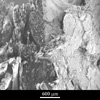Micrograph Library
Browse the libraryAdvanced searchSystemsCompositionsTechniquesKeywordsPhase diagramsHelpPreferencesAbout the micrograph libraryTerms of useContribute micrographs!FeedbackLinksCredits Print this page

Full Record for Micrograph 618

[116 KB]
View micrograph
.. in new window
View micrograph and record
.. in new window
You can also view and download the micrographs on Flickr
- Micrograph no
- 618
- Brief description
- Fracture surface of a carbon fibre composite
- Keywords
- alignment, carbon, carbon fibres
 , CFC, composite material
, CFC, composite material  , epoxy
, epoxy  , fibre
, fibre  , fracture
, fracture  , neutral axis
, neutral axis  , polymer
, polymer  , polymer composite, pull-out
, polymer composite, pull-out  , reinforcement
, reinforcement  , tensile
, tensile - Categories
- Composite, Fracture, Polymer, Polymer composite
- System
- CCcomposite
- Composition
- Carbon fibre, epoxy resin matrix
- Standard codes
- Reaction
- Carbon fibres are produced by oxidising polyacrylonitrile in air at 230 deg C whilst applying tension, and then carbonising the product in nitrogen at 1000 deg C
- Processing
- A crude carbon fibre composite was made by laying out 40 tows of fibre, painting them with epoxy resin, compressing them in a mould, and curing them for five hours at 100-190 degrees C
- Applications
- Carbon fibre composites are used as a structural material in the aerospace and automotive industries, as well as in certain high-performance sporting equipment. They present exceptional stiffness and can be structurally optimised for particular load-bearing applications.
- Sample preparation
- The bar has been bent to failure in a three-point bending rig.
- Technique
- Scanning electron microscopy (SEM)
- Length bar
- 600 μm
- Further information
- The neutral axis is clearly visible, up the centre of the image, with a region of ragged fibres indicating tensile failure to the left, and a smother, apparently crushed surface to the right where the beam was in compression. The holes and proud fibres in the tensile region are indicative of fibre pull-out which is a toughening mechanism in fibre composites.
- Contributor
- J A Curran
- Organisation
- Department of Materials Science and Metallurgy, University of Cambridge
- Date
- 03/10/02
- Licence for re-use
 Attribution-NonCommercial-ShareAlike 4.0 International
Attribution-NonCommercial-ShareAlike 4.0 International- Related micrographs

